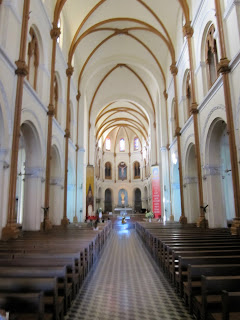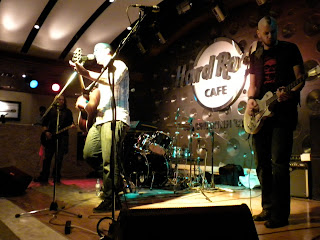We visited the Reunification Palace, which was built on the site of the Governor’s Palace. The Vietnamese took control of the Palace in 1954 when the French surrendered to the Viet Minh after its defeat at the Battle of Dien Bien Phu. The Palace was formally handed over to the Democratic Republic of Vietnam by the French General Paul Ely. In 1962, the Palace was bombed by two Vietnamese Air Force pilots who were trying to assassinate Ngo Dinh Diem, the President of South Vietnam. The Palace was badly damaged during the bombing and was ordered to be rebuilt. In 1966, Independence Palace, which was designed by Vietnamese architect Ngo Viet Thu, was completed. On April 30, 1975, a North Vietnamese tank bulldozed through the main gate of the Independence Palace, ending the Vietnam War. After the negotiations between South Vietnam and North Vietnam were finalized, the Provisional Revolutionary Government renamed the palace, Reunification Palace.


Then the group proceeded to the War Remnants Museum (previously known as Museum of American War Crimes), which primarily displays exhibits relating to the United States phase of the Vietnam War. Although difficult to handle viewing the exhibits, the group felt it was important to learn about the war from a different viewpoint.
Notre Dame Cathedral was finished in April of 1880 and subsequently the blessing ceremony was held on Easter, April 11, 1880. The French architect J. Bourad originally designed the Cathedral and in 1895 two bell towers were added. During October of 2005, a statue of the Virgin Mary was reported to have shed tears and as a result many people flocked to the statue forcing authorities to stop traffic around the Cathedral. However, the top clergy of the Catholic Church in Vietnam confirmed that the Virgin Mary did not shed tears, which nevertheless failed to disperse the crowds flocking to the statue days after the incident.


Located in the heart of the city, the Central Post Office has long been a prominent feature of Ho Chi Minh City. This grand old edifice was constructed between 1886 and 1891 by Gustave Eiffel. The architectural design of the Post Office represents the French colonial style which was popular in Vietnam at the time. The Central Post Office in Ho Chi Minh City is the largest post office in Vietnam and is well known for the huge portrait of Ho Chi Minh on its back wall.

After a long day of traveling and fortunately passing the Hard Rock Café on our bus ride back to our hotel, a majority of the group excited for American food got ready for a nice American dinner. Little did we know that the night would go above and beyond a nice cheeseburger and french fries. Quickly upon arrival the manager told us how this was the soft opening of the restaurant and a rock and roll band, American Hit Men, would be playing for nearly two hours. After meeting and enjoying some food with the band members, we now can say we were able to experience the first rock and roll band to play in Vietnam in 36 years. The combination of great food, great friends, excellent music, and watching a transition unfold in Ho Chi Minh provided an experience that we will never forget.


Lastly, we would all like to thank Professor Benson and Professor Gupta for planning an unforgettable and informative trip. Thank you also to our families for providing us with the opportunity to travel on a trip of a lifetime; we are all greatly appreciative and look forward to seeing you soon.
Posted by Roger Waesche and Doug Williams








No comments:
Post a Comment